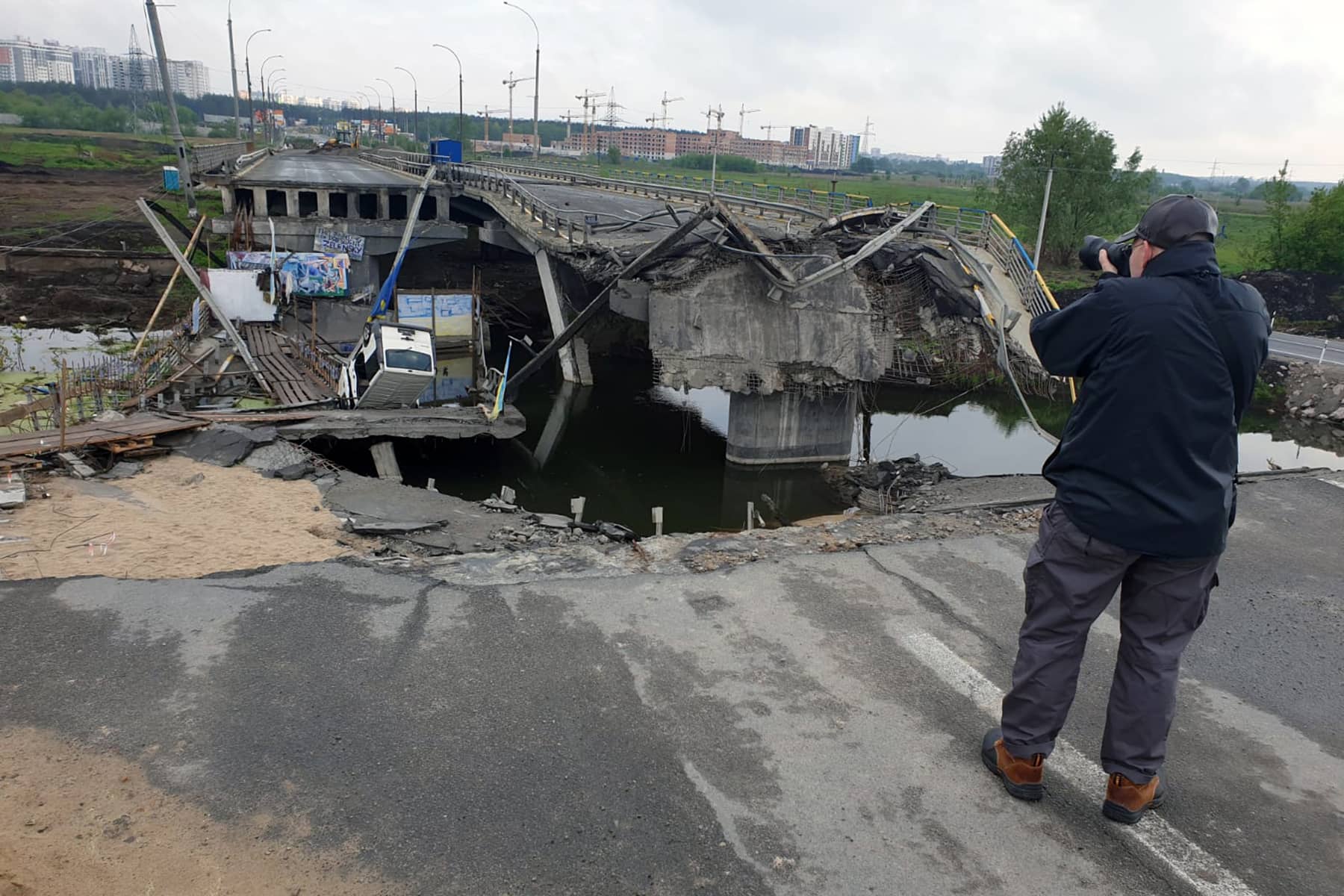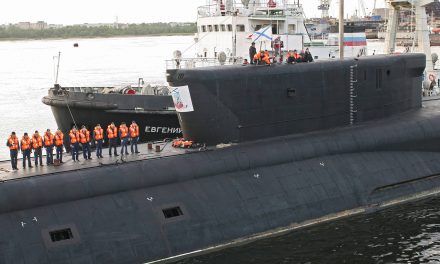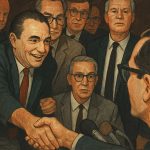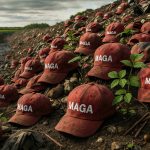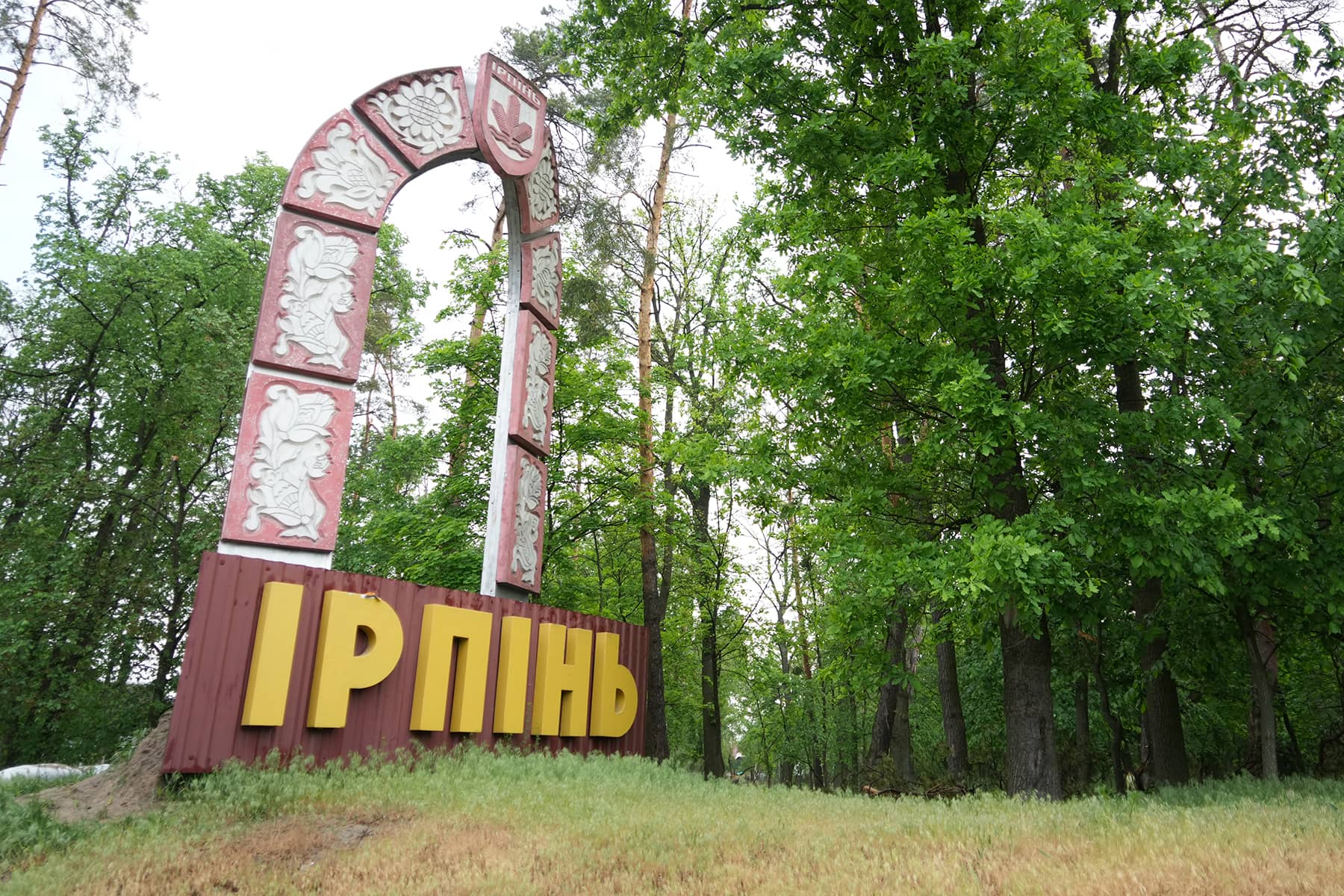
I have thought long and hard about what I would say when writing about my experience in Ukraine. The weeks of planning, all the time on the ground in a country at war, and then returning home. As hard as I tried not to compose my thoughts along the way, ideas still floated around. Writing this becomes the assembly process of all those memories. Beginning with the headline, which started as a cynical joke before I left Milwaukee. It was proven true about week later when news about Uvalde reached me in Kyiv.
By the time this special series concludes publishing on June 18, Milwaukee Independent will have published 180 articles about the invasion of Ukraine since February 24. It has been a long 100+ days, for the Ukrainians fighting to protect their homeland, and the diaspora living here in Milwaukee.
I wrote about my own Ukrainian heritage in an essay published March 1. I had already covered several protest rallies against the war, held by the local Ukrainian American community in Milwaukee. So I had been building valuable resources and contacts, and the essay was my expression of solidarity with them.
> Read: What we are taught to be ashamed of: A tale of two grandmothers and our ethnic identity in America
My photojournalism was deeply influenced by the legendary combat photographers from the Vietnam War. But I never envisioned myself becoming one, especially now that more of my career is behind me than in front of me.
On the morning of March 4, I was covering an event for a World War II veteran. While waiting for then Acting Mayor Cavalier Johnson to arrive, my friend and Milwaukee Judge Derek Mosley asked me why I was not already in Ukraine covering the war. I had not considered it and told him the notion was inconceivable. But he insisted that my style of photojournalism was needed to document the war and share those kind of images with the world.
With all my obligations for reporting news in Milwaukee, the war and everything around it all seemed so far away to me. But it got close to home very quickly that day. By the time Mayor Johnson arrived for the event, before entering the venue he held a press conference outside. He gave an update about the earlier conversation with his counterpart in Milwaukee’s Sister City of Irpin, Mayor Oleksandr Markushin.
After the event I went to work on processing the images I had taken, thinking about Judge Mosley’s words. The seed he planted started to intrigue me. But while it was entertaining to consider, I did not take it seriously. Until a few hours later.
The essay I had written on March 1 caught the attention of an international news agency. They contacted me to ask if I was interested to join a team they were sending in to Ukraine. It would not pay much, mostly my expenses, but I could photograph the war.
Over the next week I waited to hear about when I would go, and the logistical details they had to work out. So many things were in motion that if I did receive a plan by March 11, they said it was likely that everything was cancelled.
While I waited over those few days I explored backup plans for how I could go if that opportunity did not work out. But by March 10 I had given up and was not expecting to go at all. By the next day, I was asked if I could get body armor over the weekend and be ready to go the following week.
There was no body armor to be found anywhere. When I did secure a source, the shipment time was too slow. The tides reaching Ukraine seemed against me at every stroke. By the week of March 14, the Battle of Irpin was in its second week and the city was being flattened. Refugees by the millions were flooding west to Lviv, to cross the boarder into Poland.
It was impossible to predict where the war would be within a week, the timeframe of my travel window. Changes and updates seemed to happened almost by the hour at that point. All the plans could have fallen apart while I was in transit, only to arrive after 36 hours in Poland to find myself stuck.
So I reluctantly gave up on the opportunity and the idea of going to Ukraine faded. The process had been a valuable learning experience on many levels. We made wonderful connections with several photojournalists on the frontline of the war. They were sending Milwaukee Independent the images to use that other news services did not want to publish.
By March 15, Ukrainian photojournalist Sergi Mykhalchuk was covering the evacuation of citizens from Irpin. We got his images and published them the next day.
> Read: Photos from the frontlines: Sergi Mykhalchuk documents images of war as civilians evacuate Irpin
Sergi and other photojournalists allowed Milwaukee Independent to cover the war with a local voice. And that was how our work continued for the next couple weeks, until news broke on March 28 that Irpin had been liberated. The Russians were in retreat, and the impossible idea of reporting from Milwaukee’s Sister City suddenly seemed remotely possible.
By early April we were researching the logistics of reporting from Ukraine on our own. Major international news organizations already had established pipelines, Milwaukee Independent would have to build our own infrastructure. We carefully looked at what it would take to place a team on the ground in Irpin and other cities in Ukraine.
It was a stressful process, but also worthwhile. I cannot say I was excited, because it sounds really odd to be thrilled to go to war. But I did feel fortunate and blessed, and saw it as a challenge that would put my very purpose to the test. My father had been a quartermaster in the military, and I inherited his organizational skills. So even though I am a creative person, I am drawn to the mechanics of problem solving.
But there were times when superstition nearly got the best of me, wondering if everything would fall apart like before. I almost had to go just to find closure. Until I was standing in Ukraine, I was not in Ukraine no matter what my plans or intentions were.
Because the country remains in a state of war, all air traffic is cancelled. The only way in is by ground. News media also need special clearance to report from within Ukraine. There had been incidents of TV crews filming combat in realtime and giving away the positions of Ukrainian forces. There was also the constant threat of Russian infiltrators collecting intelligence.
Unless media clearance was granted by the Ukrainian Armed Forces, the trip would end before the even planning started. Thankfully, after reviewing the considerable volume of articles Milwaukee Independent had published by that time, in the neighborhood of 90, we were given military clearance. I did not envision going near the frontlines or being attached to a military unit, like I would have been in March. But, the credentials provided the access.
Russian missiles were targeting oil reserves by early May, so we were concerned about having enough gasoline to crisscross the country by van. Thankfully there was enough time for the resourceful team to secure what was needed. The whole time I was in Ukraine we only managed to find a gas station twice that was open and with a minimal wait. Most lines I saw at gas stations could easily stretch for a mile.
There were many details to plan, and so much that could go wrong. The entire project was an act of faith. While it would be easy to take credit, I do not feel that I can. If I do something that is within my ability, then it is reasonable to say I did it. But reporting from Ukraine, it was beyond me.
While the Blues Brothers may have been on a mission from God, I was not. But there was clearly a deep spiritual connection and purpose to the work. Everything turned out as planned or better, and I have to describe such an event as a miracle.
Of course, a lot of hard work and dedication went into making that miracle happen. There was no magic involved. We had to hustle, and went for 16 hours a day. I honestly do not remember sleeping at all the entire time.
Without the help of the Milwaukee Independent’s editorial team for the project, I would not have been able to take a single photograph. So very heartfelt thanks is due. Yaroslav Zdyrko provided security, logistical support, and was our videographer; Oleh Pinta was our Ukrainian and Russian language translator and reporter, and Halyna Salapata supported our work with translation services and coordinated our schedule.
There are so many stories from the project that are not mentioned in the series we produced. Like how we carried military and humanitarian supplies from Ternopil to Kyiv, items all purchased for the war effort from funds collected in Milwaukee.
Or in Lviv, when we stopped for lunch. I randomly ordered beef croquette – although semantically it was described as a cutlet. When I cut into it, a familiar smell hit me. And when I took a bite, I was transported back to my childhood. I had not tasted the dish since my grandmother – who was born in Kyiv – prepared it.
I was a finicky eater as a kid, so it was just a tasteless meatball to me at the time. I ate cutlets every summer until my teen years, and I never appreciated them. But that day in Lviv, I certainly did. The taste and trigger of memories nearly brought me to tears. I had not been on a heritage quest, my family’s history was lost too long ago. But that unexpected cultural connection was one of many welcomed encounters.
The cities in Ukraine that we reported from include: In Kyiv Oblast – Buzova, Stoyanka, Kyiv, Irpin, Bucha, Dmytrivska Community (Myla Village and Hurivshyna Village), Borodyanka, Zdvyzhivka, Mykhailivka-Rubezhivka, Zabuchchya, Berestyanka, and Novi Petrivtsi. In Rivne Oblast – Dubno, Berezyna, and Shepetyn. In Ternopil Oblast – Berezhany, Kremenets, Shybalyn, and Komarivka. In Ivano-Frankivsk Oblast – Rohatyn. In Lviv Oblast – Lviv, P’yatnychany, and Krakovets (Border Crossing).
During our first few days on the ground, when we focused on the devastation in and around Irpin, we were granted access to a high rise residential complex. Growing up in the Post-Vietnam War era, I heard a lot of stories from Veterans about boobytraps. So any time we had to move through the rubble, every dangling cord or covered object could have been a tripwire. The areas we entered were declared safe, but we still had to check. We never left anything to chance.
We explored several floors in that residential building, each seemed to be more destroyed than the previous as we traveled up. By the time we reached the top floor, Yaroslav and Oleh asked me if I was okay. They were concerned if I needed a rest. We had been climbing stairs, but I felt fine physically.
Then I realized what I had been doing, and why they asked. I was taking deep breaths before I entered each room. I later explained that I was taking the breath by instinct. Before a diver jumps into the water, they take a big gulp of air. That was exactly how I felt each time I walked into a pulverized room of shattered concrete that had once been the living space of a family.
When I stood in the doorway, I had absolutely no idea how to photograph such destruction, let alone processes the scope of it in my own mind. So I was literally taking a deep breath and jumping into the mess. My instincts took over and I went about the task of documenting the war crimes that littered the landscape around me.
It was a less surreal experience than when we first arrived in Irpin. Growing up I had spent years looking a photos of foreign places, never imagining that I would stand on the steps of the Imperial Palace in Japan or look out at Paris from the Eiffel Tower. I had only seen many places from very limited views, so the 360° perspective of standing in the Forbidden City was an “I can’t believe I’m here” moment.
For Irpin, it was never a magical destination for me, and I had only become familiar with it in a short time. But for places like the iconic bridge by the Irpin River that was destroyed at the start of the invasion to stop Russian troops from advancing to Kyiv, I had been exposed to images and videos from every angle for weeks. It had become hallowed ground, and to find myself standing at that spot felt unreal. Looking back even now it seems hard to believe I was there, but the GPS data recorded on my images proves it.
Much of the trip was like that, although in the moment I did not always make connections. It was really a voyage of discovery, where we did not know what we would find from one minute to the next. We would ask for directions and the person suddenly shared stories about the traumatic Russian occupation, before we could start recording the conversation.
In Bucha, there was a tall fence I could not see over. My Sony camera has an articulated view screen, which I use for shots where it is not possible to reach the eyepiece. I had the camera raised over the fence, only able to see basic shapes in the view screen but enough to snap some photos. Standing right under my camera in that exact spot on the other side of the fence was a home owner tending to his garden. He told us, as did everyone, many terrible stories.
Nothing we heard was particularly new. I had seen photos from the Bucha massacre for a week before they made international headlines. But in each case during my time in Ukraine, talking to someone who was sharing their personal experience, it had a completely different connection. They were no more real than stories that I already read, but they were told directly to us. We were the keepers of those memories. It was our responsibility then to tell those stories and make them real for others in Milwaukee.
If I had to describe the conditions I saw in Ukraine, I would use the example that it felt like COVID did in America in 2020. In a social sense, the war is affecting the whole country. But the immediate impact was different depending on proximity to it.
Even in Irpin, there were some parts where we would never have imagined a war happening. Other parts were in ruins and it seemed hard to fathom that anyone in the area was left alive. As we traveled it was like riding a pendulum, constantly swinging from what appeared to be normality to utter desperation.
And in the middle of all those experiences, finally detached from events in America, news reached me about Uvalde and yet another mass shooting of children. At least in Ukraine they knew who the enemy was. Americans seem to be chasing shadows in circles and finding new ways to blaming each other. Even from that distance in Ukraine I could not take a break from the insanity that American culture has become.
The best analogy I can think of is sitting in a cafe and watching someone pee into an empty mug and then walking away. Soon after, they scream about who was to blame for their coffee tasting like urine. There is a complete disconnect in how Americans think, between cause and affect. It bewilders me to see people support the very political structures that are responsible for destroying their lives.
As for Ukraine, they want to be like America. I hope they can be better. They want to protect their independence and rights. Having freedom means having the ability to make bad choices. But I saw so many good people, all wishing they could do more to help their nation, helpless to end the war but making every effort to bring that day closer.
Americans can learn a lot from the Ukrainian people and take inspiration from their example. We will continue to make bad choices, but if enough or our neighbors care about making our country better – and not just finding who to blame for their own selfish expectations, our world would drastically improve. Hate has never helped anything.
I found a lot of beauty and hope in Ukraine. I also concluded that there was no adequate words in English to properly describe the impact of Russia’s brutality. If “monstrous” and “evil” sound too biblical, then it would be because what I saw – even far from the frontlines – was like stories of suffering from the Old Testament.
The nation has already experienced more than 100 days of war since the February invasion, on top of 8 years since Ukraine’s Crimean territory was illegally seized. After such a long time, I can understand why folks in Milwaukee would tune out what happens. Out of sight out of mind, even important things fade. This is the first full summer season not overwhelmed by a cloud of COVID, which is an attractive distraction from the past two years of trauma.
I cannot make people in Milwaukee care about Irpin or the war, but I can stand as a witness so that they are not forgotten. What is happening in Ukraine is connected to many events playing out right here in Wisconsin. No other news media organization in the state has reported from within Ukraine since the invasion began. Milwaukee Independent was the first, and so far only team of reporters to do so. We hope to produce more stories from distant places with local connections in the future.
Слава Україні! Героям слава! 🇺🇦
Series: Reports from Ukraine
- Reports from Ukraine: Traveling from Milwaukee to a country at war just to take a vacation from America
- Images from Ukraine: Latino artist travels to Irpin to paint mural inspired by "Echoes of Guernica"
- Images from Ukraine: Irpin residents welcome reissue of Russian Warship Stamp as latest sign of victory
- Stories from Ukraine: Wandering in the ruins of a shattered life after surviving Russia's invasion
- Images from Ukraine: Similar to the Alamo, martyred cities bought precious time to save a nation
- Stories from Ukraine: Tent camp offers shelter for displaced residents until Irpin can rebuild lost homes
- Images from Ukraine: Graveyards of Russian war machines show the scale of Putin's failure to seize Kyiv
- Images from Ukraine: Following the invasion convoy's 40-mile route and exploring an abandoned base
- Stories from Ukraine: Illegal weapons and proof of Russian War Crimes easily seen along streets of Irpin
- Images from Ukraine: How Irpin’s cemetery processed the staggering massacre of its local citizens
- Stories from Ukraine: Healing remains slow as Borodyanka residents recover from occupation
- Images from Ukraine: The deep scars of war remain visibly etched across the landscape of Borodyanka
- Interview with Oleksandr Markushin: Mayor of Irpin and the hero of a Hero City
- A Meeting of Sister Cities: Former and current Mayors of Irpin ask Milwaukee's business community for help
- Stories from Ukraine: Having a shared purpose helped Irpin's leaders protect the city and stop the invaders
- Stories from Ukraine: How Milwaukee helped a bakery feed hungry survivors in Bucha with fresh bread
- Stories from Ukraine: Bucha resident recalls how Russians turned neighborhood into a street of death
- Stories from Ukraine: How a mass grave of executions overshadowed accountability from Bucha’s leadership
- Images from Ukraine: Putin’s attack on Babyn Yar is a painful reminder of the broken vow of “Never Again”
- Images from Ukraine: An unexpected encounter with Jewish history and the bloody legacy of persecution
- Images from Ukraine: Listening to timeless voices of ethnic heritage etched in stone at Lychakiv Cemetery
- Images from Ukraine: The experience of attending a military funeral in Kyiv while children died in Uvalde
- Images from Ukraine: Stepping out of the fog of war to see the beauty of faith in ancient places of worship
- Images from Ukraine: The cities of Kyiv and Lviv were divided by history but remain united in identity
- Stories from Ukraine: Anya Nakonechna shares why the Lviv Opera is a symbol of her nation’s culture
- Images from Ukraine: A folk village where visitors can experience the life of past generations
- Images from Ukraine: Signs of renewal sprout from under Irpin’s rubble as city looks to the future
Lее Mаtz
Lее Mаtz and Yaroslav Zdyrko
Milwaukee Independent editorial team for this special series: (UKRAINE) Lee Matz, photojournalist; Oleh Pinta, translator / reporter; Yaroslav Zdyrko, security / videographer; (MILWAUKEE) Halyna Salapata, logistics / translations.
Milwaukee Independent has reported on the situation in Ukraine since it was invaded on February 24. Coverage originally began with reactions and rallies from the local Ukrainian American community, and relationships with Milwaukee’s sister city of Irpin. Through partnerships and good journalism, sources were developed that enabled Milwaukee Independent to publish developments about the unprovoked war in realtime. In late May, a team from Milwaukee Independent spent nearly two weeks on the ground in Ukraine. The award-winning daily news magazine was the first and, at the time, only media organization to send staff into the country since the war began.
Reports from Ukraine: An extensive news series by Milwaukee Independent from a country at war





